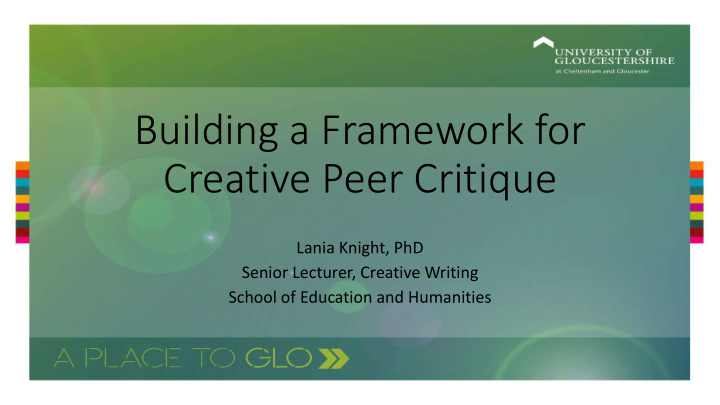



Building a Framework for Creative Peer Critique Lania Knight, PhD Senior Lecturer, Creative Writing School of Education and Humanities
Vision “ How do we create a framework so students engage with peer critique in meaningful, constructive ways?
Let’s begin with the Creative Writing Workshop
Students learn to practice peer critique in a Creative Writing Workshop through enquiry- based learning.
I give a range of questions to my students when preparing for workshop.
Asking Questions I ask my students: What are your initial observations? What is this story about? What questions does the opening bring to mind? Do you want to read on? How does the formatting look? Does it follow guidelines?
Asking Questions I ask: Can you describe how the story is told? How would you describe the use of language? Does the story flow naturally?
Asking Questions I ask: Can you describe your response to the story? Did you get so caught up in the story that you lost sight of the fact that you were reading? Can you go back and pinpoint where in the story that happened for you?
Asking Questions I ask: Can you describe the use of tools of the craft? Does the story make use of sensory details? Is there any use of interiority, or interior monologue? How would you describe the ratio of showing to telling? What is your sense of characterization? Briefly describe the character arc, the narrative arc.
Asking Questions I ask: Can you make connections ? Does the story remind you of anything else you’ve read ? Do you have any suggestions for books or short stories the student might want to read?
Asking Questions I ask: Can you take meaning from the story ? If this story is arguing something about the way the world works, what is that argument? If this story is arguing for some kind of change in the world, what is that change?
How can your students apply questions from Creative Writing Workshop for peer critique?
Applying the questions initial observations how the story is told their response tools of the craft connections meaning
Applying the questions What are their initial observations?
Initial Observations acknowledge that the student-critic has engaged with the work to be critiqued.
Applying the questions Can the student- critic describe ‘ how the story is told’?
Describing ‘ how the story is told’ or the media it relies on defines the mode and the parameters of the project.
Applying the questions Their response: what did the student-critic feel?
Conveying how the work made the student- critic feel helps the student- artist understand how well they’ve carried out their intentions.
Applying the questions What tools of the craft were used?
Pointing out tools of the craft helps the student-critic and student-artist become familiar with terminology from the discipline and how to use it appropriately.
Applying the questions What connections are there between this and other work already produced?
Seeing connections between the student- artist’s work and other creative work in the same discipline helps the student- critic and the artist see how the work is part of a larger conversation.
Applying the questions What meaning or message can be taken from the student- artist’s work?
Identification of the meaning or themes within a work-in- progress by the student-critic can help the student-artist see what they might be arguing for or against in their creative work.
Given tools for peer critique, students will begin to see creative work with new eyes.
Additional Resources • Gray , C. (2013) ‘Informal peer critique and the negotiation of habitus in a design studio’. Art, Design & Communication in Higher Education. 195-209. • Hastings, D. (2017) ‘ “With grace under pressure”: How critique as signature pedagogy fosters effective music performance’. Arts & Humanities in Higher Education. 252-265. • Heinert , J. (2017) ‘Peer critique as a signature pedagogy in writing studies’. Arts & Humanities in Higher Education. 293-304. • Schrand , C. and Eliason J. (2012) ‘Feedback practices and signature pedagogies: what can the liberal arts learn from the design critique?’ Teaching in Higher Education. Routledge: London: 51-62. • Stukenberg , J. (2017) ‘Deep habits: Workshop as critique in creative writing’. Arts & Humanities in Higher Education . 277-292.
Contact me for further ideas and conversation about peer critique and enquiry-based teaching. Dr Lania Knight lknight2@glos.ac.uk
Recommend
More recommend